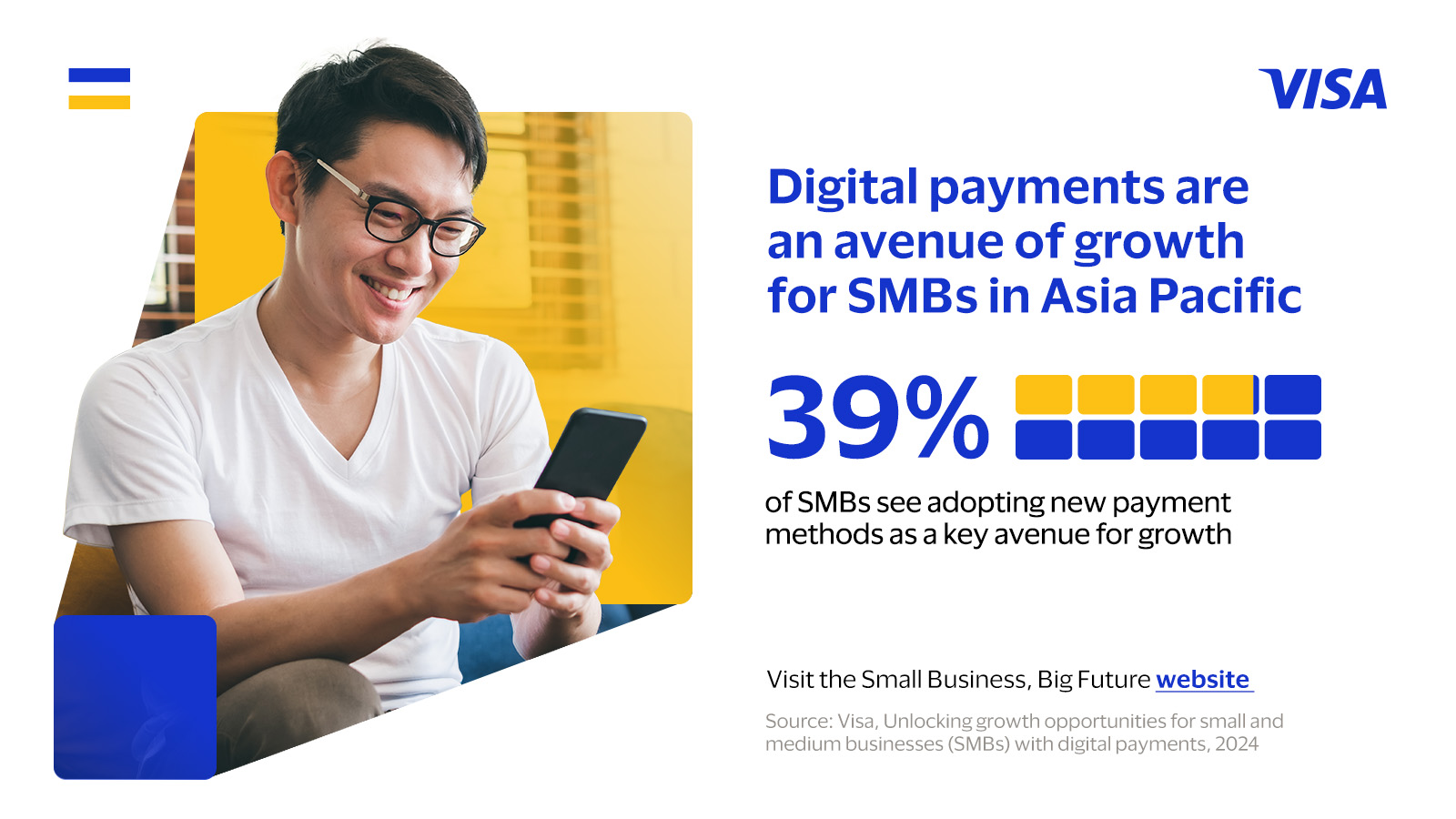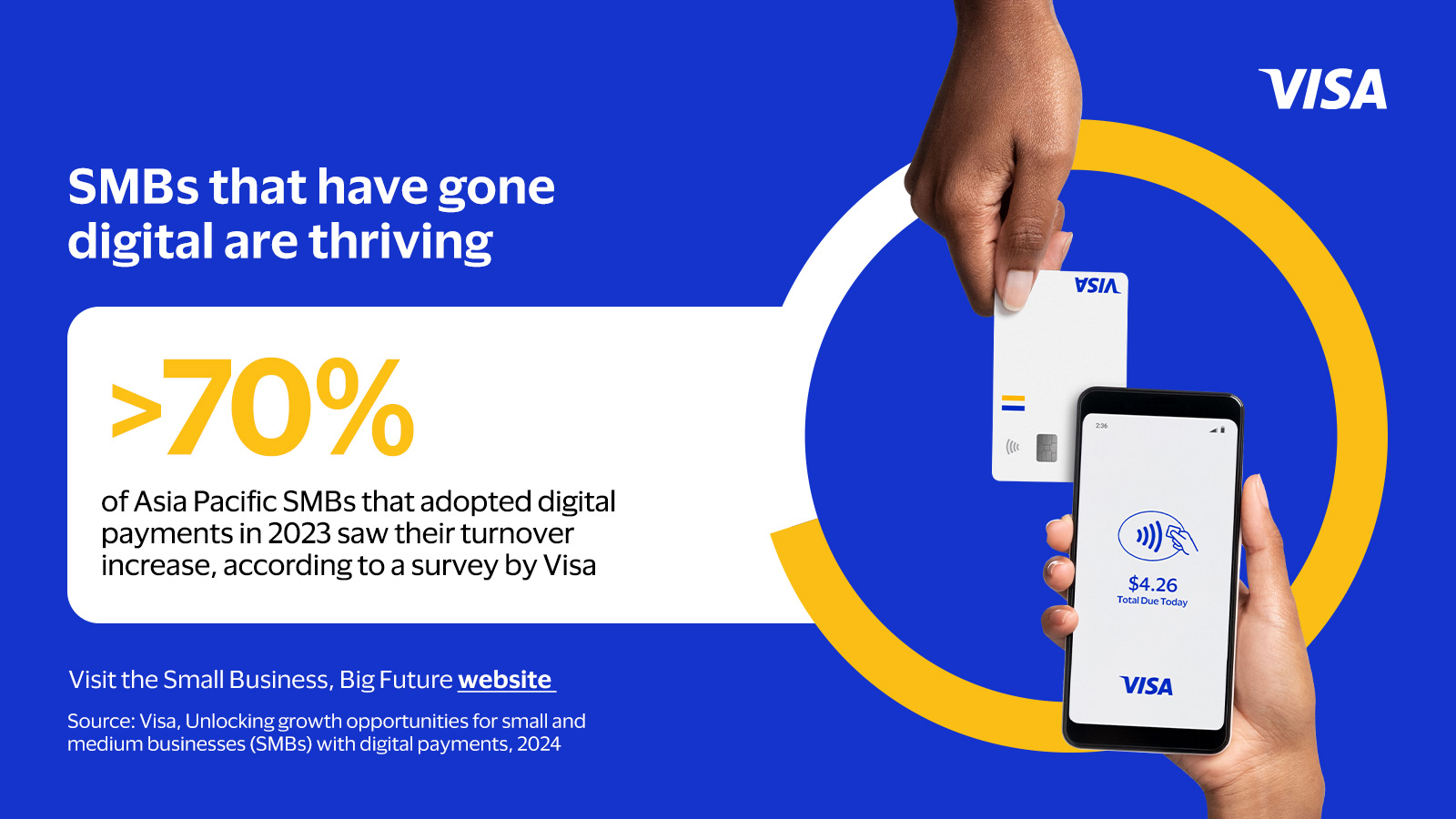Why going digital is a recipe for growth for SMBs in Asia Pacific

Small and medium-sized businesses (SMBs) in the Asia Pacific region grapple with various challenges daily, including difficulties in keeping up with changing consumer habits and manual operations that slow down their business. However, many SMBs are finding that digital payments might be a way to solve many of their challenges. According to research by Visa, 39 per cent of SMBs see the adoption of new payment methods as a key avenue for growth.¹
Digital payments are no longer just about transactions. Digital payments enable SMBs to serve consumers new products through new channels. Indeed, SMBs that have gone digital are thriving. In 2023, over 70 per cent of Asia Pacific SMBs that adopted digital payments saw their turnover increase compared to before, according to a survey by Visa.2
But what makes digital payments so crucial in the recipe for SMB success? There are three critical reasons: digital payments meet modern consumer needs, enable more efficient processes, and facilitate international growth.
Reaching the new digital consumer
Today, Asia Pacific’s consumers prefer the convenience and efficiency of digital financial services and platforms. According to Visa’s Green Shoots Radar report, over a third of Asia Pacific consumers applied for a card in the first half of 2023.³ Of those, 43 per cent of consumers stated that they sought new cards mainly to integrate with their mobile wallets, a clear shift toward digital payments.⁴
For SMBs, digital payments are critical. Once SMBs start accepting digital payments, they will be able to service this digital segment of cashless customers not only for transactions directly but also for additional value-added services. Digital payments allow SMBs to trade on digital platforms, which provide services like web store builders and microloans, among others. These services enable SMBs to bolster their offerings to better meet consumer needs, delivering the products and services they want—where, when, and how they need them. Initiatives like Buy Now, Pay Later, and rewards programmes further strengthen consumer loyalty, building a stronger bond with consumers for repeat business.

Unlocking faster, smarter, and secure processes
The advantages of embracing digital payments go beyond just consumer demand. SMBs stand to gain significantly by streamlining their internal processes, accounting or otherwise, cutting down costs associated with manual operations, and implementing enhanced security for long-term peace of mind and growth.
Take FoodXervices, a Singapore-based food distribution company. More than a decade ago, the company embarked on a journey towards digitalisation, transforming its manual payment procedures and vastly improving operational efficiency. By transitioning to digital payments, FoodXervices transacted with vendors and consumers without workers having to manually account, manage, and transport cash themselves. According to owner Nichol Ng, putting more purchases on cards has helped workers save time by 30 per cent as compared to transacting with cash.
This secures and accelerates payments, mitigates risks from potential accidents or unforeseen circumstances, and streamlines accounting and payment reconciliation.
Moreover, harnessing the power of data analytics derived from digital payment transactions provides SMBs with invaluable insights for making informed business decisions. By gaining insights into consumer behaviour and transaction patterns, SMBs can fine-tune their operations and tailor their offerings to better align with market demands.
Launching into global markets
Digital payments are also crucial for SMBs to access global markets. In Asia Pacific, 88 per cent of SMBs see selling internationally as a key growth opportunity . With four out of five SMBs planning to expand internationally, digital payments will be an important tool that can help them overcome distance and reach consumers worldwide.⁶
TeaDailyGo, a Vietnam-based tea retailer, is also an example of an SMB breaking international barriers with digital payments. By accepting online transactions enabled by Visa, the company can serve tea enthusiasts worldwide. Global consumers from United States, Canada, and Japan purchase tea rapidly and securely through its website easily, allowing the retailer to reach new consumer segments and drive loyalty.⁷
Furthermore, advancements in payments technology allow SMBs to excel in markets with little payment or technology infrastructure. Innovative solutions like the Tap to Phone app enable SMBs to transform ordinary mobile devices into point-of-sale terminals, eliminating the need to invest in extensive digital payment infrastructure. This simplified approach allows SMBs to connect with and serve previously untapped consumer segments swiftly.

Solutions and policies are key to the recipe for growth
As SMBs navigate the ever-changing digital landscape, staying ahead of evolving consumer and business needs is key to remaining competitive. This means embracing innovative solutions and supportive policies as part of the recipe for growth.
It is crucial that payment solutions are in sync with SMBs' growth requirements. Exciting advancements in areas like embedded finance services and cross-border payment platforms offer promising opportunities for SMBs to streamline their payment processes and adapt to changing market needs.
Countries like Singapore, Malaysia, and the Philippines also lead the way with proactive policies and payment transformation roadmaps. For instance, in early 2024, the Philippines' Bangko Sentral ng Pilipinas (BSP) managed to shift half of total retail payments nationwide to digital channels in 2023. Looking ahead, the BSP is charting the next phase of the country’s digital journey under the 2024-2026 Digital Payments Transformation Roadmap, focusing on onboarding more SMBs onto digital payments.⁸
By embracing these key elements, SMBs can effectively leverage digitalisation to fuel their growth and ensure long-term success in today's digital age.